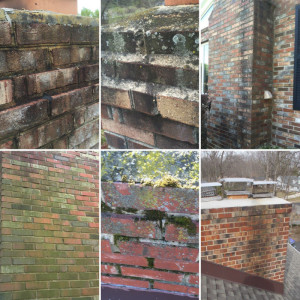If you have an older chimney, discoloration can be easy to dismiss as a natural part of the aging process. If your chimney is turning colors, however, it usually indicates a larger problem. The exact shade of chimney discoloration usually provides a decent indication of what the problem is. So what color is your chimney?
White
White stains on your chimney, called efflorescence, are mineral deposits left behind when rain and moisture evaporate. Efflorescence stains on the sides of chimneys are usually chalky or crystalline looking. They can be merely cosmetic and indicate nothing more than the amount of precipitation your chimney endures. However, efflorescence also can indicate that water is running down the inner walls of your chimney, evaporating and leaving efflorescence behind. White chimney staining should always be investigated by a chimney professional to ensure that water isn’t leaking into your chimney and causing damage. If it’s determined that the efflorescence is being caused by the elements and not by water leaks, the white staining is a cosmetic issue that should wash away easily.
Green, Blue, or Black Stains
Green, blue or black stains down your chimney walls should raise a major alarm. Those types of staining usually are caused by mold or algae growth on your chimney’s masonry, which indicates that your chimney is being subjected to large quantities of moisture. This could be due to cracks in the chimney allowing water in, or due to an external source, such as an overflow of water from a blocked gutter. If you see green, blue or black stains on your chimney and suspect water damage, call a chimney expert immediately. Unchecked water damage can compromise your chimney’s structure and cause damage to your home’s structure.
Black or Brown Streaks
Black or brown streaking down the sides of your chimney is usually caused by creosote washing down the walls of your chimney. This can either be due to a buildup of creosote and soot on your chimney cap — a sign that your fireplace isn’t burning properly or that your flue is improperly sized for your heating appliance — or due to cracks in the chimney’s masonry that are allowing soot to seep out of the sides of your chimney. This can be an incredibly dangerous situation, as it means that your chimney isn’t venting properly. That could expose your home to carbon monoxide. A chimney inspection should be able to locate any cracks and check that your fireplace is burning properly.
While it can be tempting to dismiss chimney discoloration as a normal part of your chimney’s aging process, don’t ignore it! It can indicate a major problem that endangers your chimney’s structure and your home. If your chimney has an unusual color, call Clean Sweep of Anne Arundel County today to schedule an inspection and consult with one of our chimney experts.
